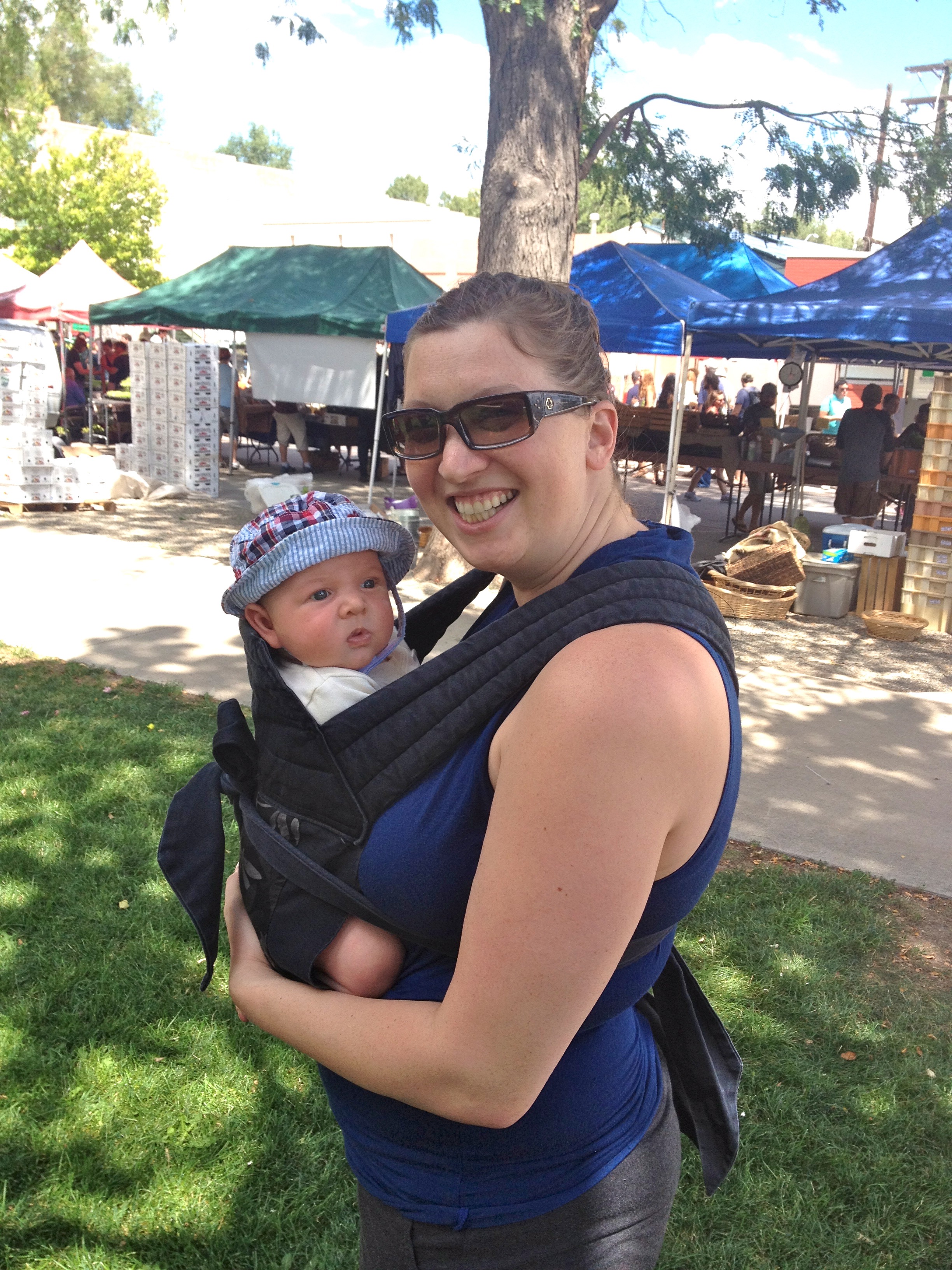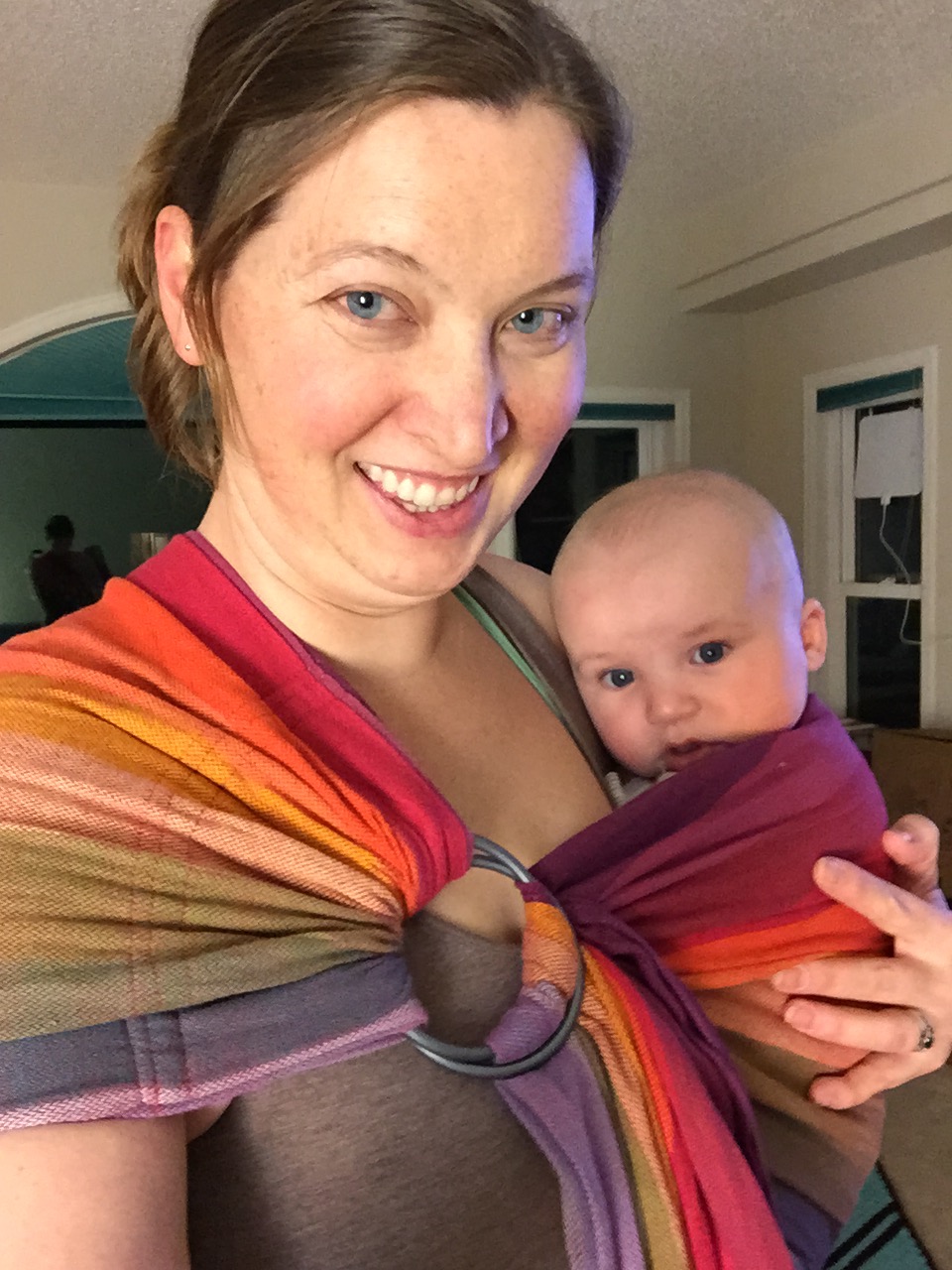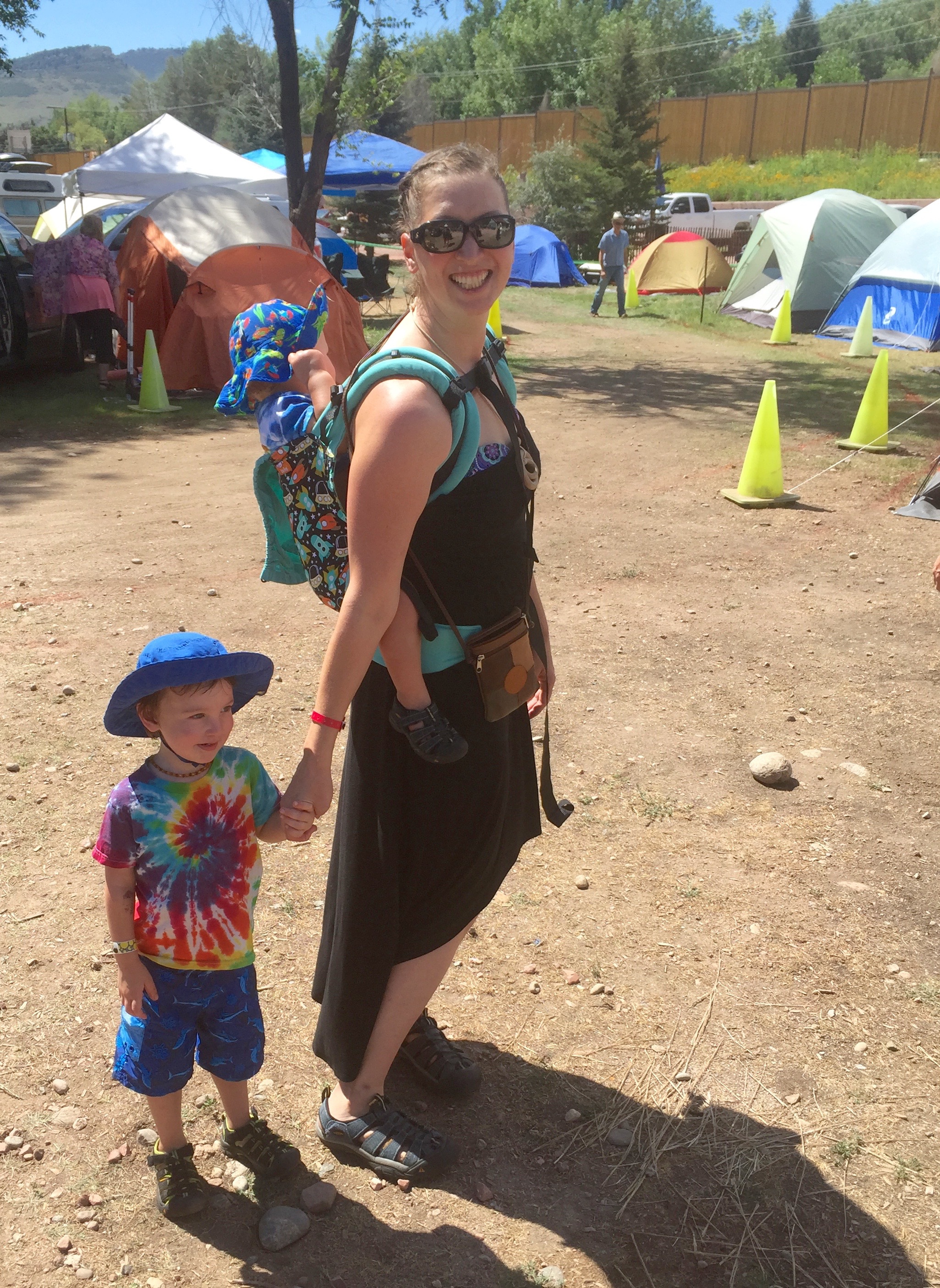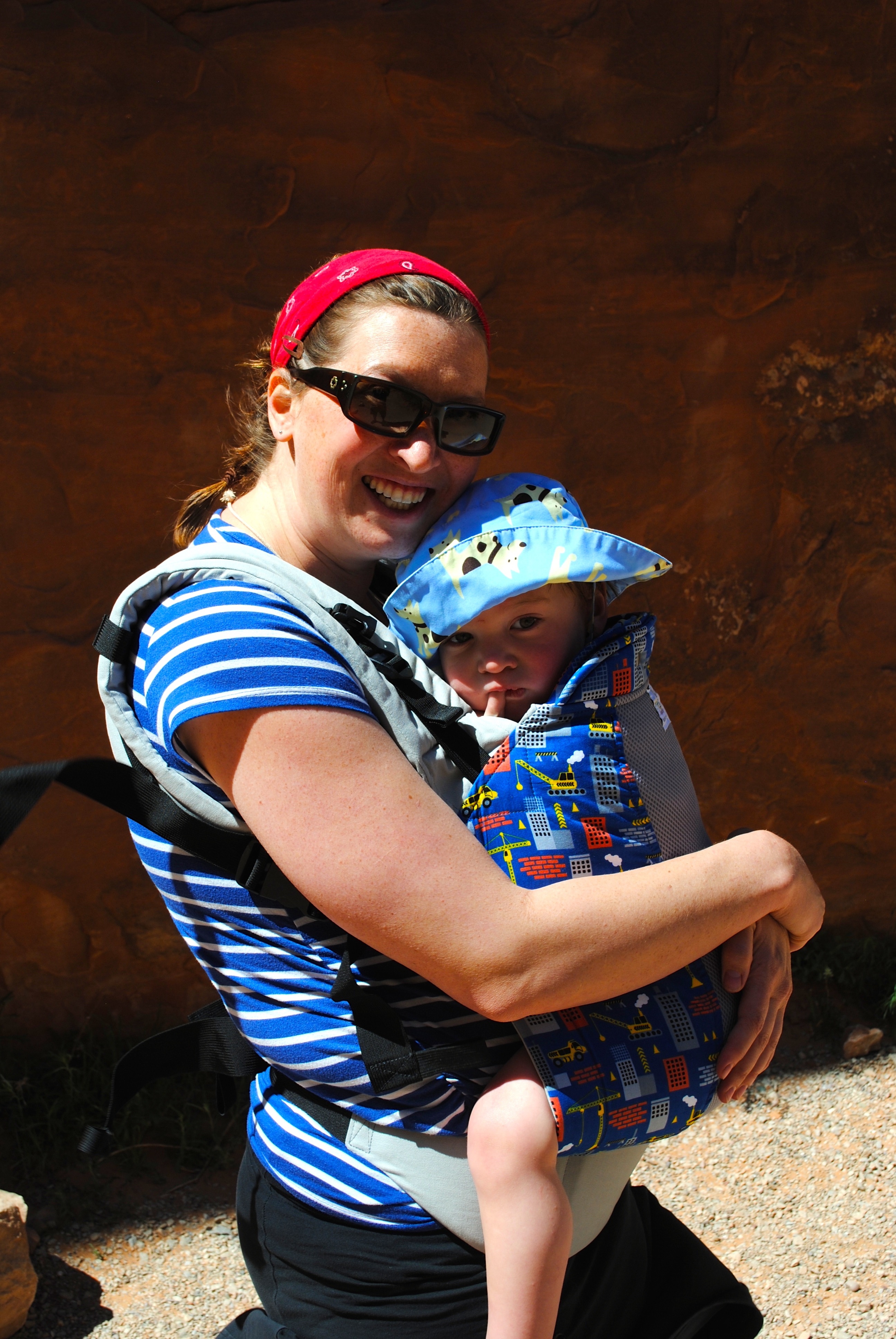Babywearing for Parents with RA
There are many benefits to babywearing – from increased bonding, to reduced crying, and the ability to get something done! But for parents living with rheumatoid arthritis, there may be some added benefits – like the ability to hold and carry your baby even if your hands and wrists are flaring!
After more than four years of wearing both of my boys, I honestly can’t imagine motherhood without the benefits of babywearing. However, I also know that there are a lot of different types of carriers out there, so it can be difficult to determine which one will best suit your needs. For that reason, I wanted to share my experiences with different types of carriers from the perspective of a mom with RA.
How does a wrap work with RA?
 A wrap is a long piece of cloth that is tied around your body in various ways. Wraps come in a variety of lengths and different types of fabrics. Stretchy wraps, like the Moby, are only suitable for newborns worn on your front, and eventually babies get too heavy for this type of wrap. Woven wraps are more versatile and can be tied in many different ways to carry babies of many different sizes on your front, side, or back (plus they are often so beautiful!) But while woven wraps are definitely versatile, there is a big learning curve in figuring out how to use one safely. I also found that I generally lacked the necessary hand strength to tie most of the knots and properly adjust all the folds of fabric. And while I did use a Moby for a while with my first baby, I generally found that the amount of fabric made it too warm for us to use for longer periods of time. If you are new to babywearing I would not recommend starting with a wrap – especially if you have RA.
A wrap is a long piece of cloth that is tied around your body in various ways. Wraps come in a variety of lengths and different types of fabrics. Stretchy wraps, like the Moby, are only suitable for newborns worn on your front, and eventually babies get too heavy for this type of wrap. Woven wraps are more versatile and can be tied in many different ways to carry babies of many different sizes on your front, side, or back (plus they are often so beautiful!) But while woven wraps are definitely versatile, there is a big learning curve in figuring out how to use one safely. I also found that I generally lacked the necessary hand strength to tie most of the knots and properly adjust all the folds of fabric. And while I did use a Moby for a while with my first baby, I generally found that the amount of fabric made it too warm for us to use for longer periods of time. If you are new to babywearing I would not recommend starting with a wrap – especially if you have RA.
Mei tai carrier with RA
 A mei tai is a square of fabric, which becomes the baby’s seat, and straps that go around your waist and over your shoulders. Mei tais are great because they can be adjusted for a perfect fit, so the same carrier can be used by different sized parents. I liked my mei tai because it was cooler than the wrap and because I could adjust it to fit my comfort. There were several options for tying it and I was even able to use it to support breastfeeding. On the positive side, mei tais are generally less expensive than soft structured carriers. However, on the downside, my boys did eventually reach a weight where the mei tai wasn’t supportive enough for my body. Additionally, you have to have enough use of your hands to be able to tie and untie knots, which wasn’t always a possibility for me.
A mei tai is a square of fabric, which becomes the baby’s seat, and straps that go around your waist and over your shoulders. Mei tais are great because they can be adjusted for a perfect fit, so the same carrier can be used by different sized parents. I liked my mei tai because it was cooler than the wrap and because I could adjust it to fit my comfort. There were several options for tying it and I was even able to use it to support breastfeeding. On the positive side, mei tais are generally less expensive than soft structured carriers. However, on the downside, my boys did eventually reach a weight where the mei tai wasn’t supportive enough for my body. Additionally, you have to have enough use of your hands to be able to tie and untie knots, which wasn’t always a possibility for me.
Using a ring sling with RA
 A ring sling is a piece of fabric with two rings sewn at one end. The tail of the fabric is fed through the rings, so that the fabric goes across your body like a sash and the baby sits in the pocket created. I didn’t have a ring sling with my first baby, but I loved using one the second time around! It can take some practice to figure out how to wear one properly, but after some practice I found it took less effort for my hands than a wrap or a mei tai. It was quick to put on and easy to nurse in – which was especially useful because I was also chasing an active toddler! It also is significantly less fabric than a wrap so it was much cooler. The downside of ring slings is that it does put all of the baby’s weight on one shoulder, which can be problematic for anyone but especially if you have RA. There are several different styles of shoulders that can be used to help distribute this weight (pleated, gathered, eesti, padded, etc.) and it can also be useful to switch which shoulder you use. I used my ring sling a lot during my second little dude’s first year, but generally only for quick carries (from the car to the park, for example) or nursing sessions. If I knew I would be wearing him for a longer period of time, I generally chose a soft structured carrier instead.
A ring sling is a piece of fabric with two rings sewn at one end. The tail of the fabric is fed through the rings, so that the fabric goes across your body like a sash and the baby sits in the pocket created. I didn’t have a ring sling with my first baby, but I loved using one the second time around! It can take some practice to figure out how to wear one properly, but after some practice I found it took less effort for my hands than a wrap or a mei tai. It was quick to put on and easy to nurse in – which was especially useful because I was also chasing an active toddler! It also is significantly less fabric than a wrap so it was much cooler. The downside of ring slings is that it does put all of the baby’s weight on one shoulder, which can be problematic for anyone but especially if you have RA. There are several different styles of shoulders that can be used to help distribute this weight (pleated, gathered, eesti, padded, etc.) and it can also be useful to switch which shoulder you use. I used my ring sling a lot during my second little dude’s first year, but generally only for quick carries (from the car to the park, for example) or nursing sessions. If I knew I would be wearing him for a longer period of time, I generally chose a soft structured carrier instead.
How does a soft-structure carrier work?
 A soft structured carrier is similar to a mei tai, but instead of having to tie knots these carriers feature adjustable buckles – which are generally much easier on RA hands! Soft structured carriers come in a wide variety of shapes and sizes and, once the baby is big enough to hold his own head up, can also be used for back carries. My husband and I both loved the Beco Gemini when our boys were little - especially because there was an option for the boys to face out – but our boys quickly reached a weight where the Beco wasn’t supportive enough. After that we each developed our own preferences – my husband prefers the Kinderpack while I prefer the Tula. I’ve also heard good things about Ergobaby, Lillebaby, and Boba. Each brand will fit each person a little bit differently, so the best thing you can do if you are considering a soft structured carrier is to try on several different brands before deciding. A baby boutique that sells carriers or your local chapter of Babywearing International are great places to try on carriers.
A soft structured carrier is similar to a mei tai, but instead of having to tie knots these carriers feature adjustable buckles – which are generally much easier on RA hands! Soft structured carriers come in a wide variety of shapes and sizes and, once the baby is big enough to hold his own head up, can also be used for back carries. My husband and I both loved the Beco Gemini when our boys were little - especially because there was an option for the boys to face out – but our boys quickly reached a weight where the Beco wasn’t supportive enough. After that we each developed our own preferences – my husband prefers the Kinderpack while I prefer the Tula. I’ve also heard good things about Ergobaby, Lillebaby, and Boba. Each brand will fit each person a little bit differently, so the best thing you can do if you are considering a soft structured carrier is to try on several different brands before deciding. A baby boutique that sells carriers or your local chapter of Babywearing International are great places to try on carriers.
Toddler carrier and rheumatoid arthritis
 Especially for parents living with RA, your toddler will likely reach a weight where carrying them becomes more of a burden on your body than a help. But even though I don’t carry my boys that often or that long anymore, there are definitely still times when having a toddler carrier on hand is extremely useful – like going through airport security or hauling an exhausted kid back to the car. Being worn has become a very happy place for my boys, so sometimes just a few minutes in the carrier can reset their entire mood and help us get through the day. Even though my boys are much heavier now, carrying them is sometimes unavoidable – so having a toddler carrier to help distribute their weight is still extremely useful.
Especially for parents living with RA, your toddler will likely reach a weight where carrying them becomes more of a burden on your body than a help. But even though I don’t carry my boys that often or that long anymore, there are definitely still times when having a toddler carrier on hand is extremely useful – like going through airport security or hauling an exhausted kid back to the car. Being worn has become a very happy place for my boys, so sometimes just a few minutes in the carrier can reset their entire mood and help us get through the day. Even though my boys are much heavier now, carrying them is sometimes unavoidable – so having a toddler carrier to help distribute their weight is still extremely useful.
Join the conversation